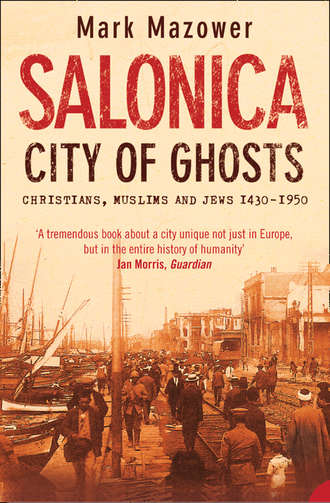
Полная версия
Salonica, City of Ghosts: Christians, Muslims and Jews
Nevertheless, during the eighteenth century, the balance of economic activity within the empire was changing as wars with Persia hit the Anatolian trade and Europe’s new prosperity made Rumelia more commercially important. Salonica, as the chief port for the Balkans was poised to profit. Izmir was busier, but a much higher proportion of Salonica’s traffic was directed west and north and its trade deficit with Asia and the Middle East was more than outweighed by its surplus on the growing exchange with Europe. Exports of locally-produced grain, cotton, salt and tobacco as well as wax, hides, furs and fats from the Danubian Principalities and Russia paid for Murano glass, books, fine velvets, Italian paper and even furniture. Mid-century also saw a boom in the illegal smuggling of antiquities – one Venetian shipment included five entire columns plus another one hundred ‘stones’ – until the exporters [mostly French and Greek] damaged the roads, houses and even cemeteries so badly that the authorities put a stop to it.5
Despite the increasing competitiveness of French and English textiles, indigo and American coffee, the trade gap in Salonica’s favour remained. It was filled by coin – Ottoman aspres and piastres, the Cairene fundukli and the Stambul zermahboub as well as German and Hungarian thalers, Spanish doubloons and Venetian ducats and sequins. Demand was so high that counterfeits entered the market produced in bulk by enterprising villagers in the Ionian islands – under Venetian control – and the towns of western Macedonia. Both the Ottoman and the Venetian authorities tried vainly to stop them. But despite the constant depreciation in the value of the Ottoman piastre, it was generally traded above its official rate, such was the foreign demand.6
Some European items did appeal to the elite. Heavy English watches, encased in silver, and preferably made by George Prior or Benjamin Barber sold thirty dozen annually, reflecting the scarcity of public clocks. Lyons carpets and gold-fringed Genoese damasks adorned the wealthier haremliks, while the beys, as they had always done, wintered in caftans lined with Russian ermine, sable, fox and agneline. Tastes were slowly changing. The French consul Cousinéry was impressed by the contrast in living styles between the old Albanian bey of Serres, Ismail, who had ‘banished all interior luxury’ which he regarded as ‘useless and ruinous’, and his son Yusuf, who spent the substantial fortune he acquired as deputy governor of Salonica on his country palace, its walls painted to imitate marble, the whole ‘a melange of Oriental ostentation and European taste’ – elegant divans, richly decorated wood-panelled doors and windows, combined with Bohemian crystal in the window-panes, English carpets and gilt-framed pictures in the harem. Yet someone as wealthy and ambitious as Yusuf Bey – the most powerful man in the city in his heyday – was probably the exception. In general, Muslim taste was far less profligate and directed not to European manufactures but to coffee, fruits, metal-work, spices and fabrics which the empire itself supplied. In fact, according to one irritated consul, the average Salonican Muslim simply did not consume enough:
Always the same in his way of being, of living, and of dressing, the pleasures and the wants of yesterday are to him the pleasures and wants of tomorrow. Rich or poor, he puts on every morning the same woollen cloth, and lays it aside only when he has worn it entirely out, in order to purchase another of the same quality, the same price, and the same colour. He has drunk coffee in his childhood, he will drink it in his old age. He will not forsake old habits, but he will not imbibe new ones. This stupid monotony in habits and taste must set constant limits to the consumption of our commodities.7
Конец ознакомительного фрагмента.
Текст предоставлен ООО «ЛитРес».
Прочитайте эту книгу целиком, купив полную легальную версию на ЛитРес.
Безопасно оплатить книгу можно банковской картой Visa, MasterCard, Maestro, со счета мобильного телефона, с платежного терминала, в салоне МТС или Связной, через PayPal, WebMoney, Яндекс.Деньги, QIWI Кошелек, бонусными картами или другим удобным Вам способом.


